Which jeans have the best fit? Jeans fit for your body type
Jean fit types, terminology, and pattern division principles vary significantly among manufacturers. This is explained different approaches, values and marketing strategies of companies. This article provides a breakdown of the most common types of jeans fits.
Basic types of fit for women's jeans
The most popular type of planting today. Tapered cut, tight-fitting jeans along the entire length of the legs, “fitting.”
Skinny fit
Tight-fitting silhouette, even tighter-fitting tapered cut than slim fit, “second skin”.
Jeggings fit
A symbiosis of leggings and “denim” material. Leggings+Jeans=Jeggings. Denim leggings always contain elastane.
Straightfit
Boot cut fit
Flared cut of jeans. Extension height varies significantly across models and manufacturers. A special case is Flare fit - widening the width of jeans from the hip.
Boyfriend fit
"My boyfriend's jeans." Current cut, copying the cut of men's jeans.
Relaxed fit
The most ambiguous definition of the types of fit of loose-fitting jeans. The understanding of loose fit varies greatly among manufacturers and even among models of the same brand. Generally, characteristic features are a loose cut, an increased crotch seam (matnya), the most common fit is “tapered leg”. Similar type cut - Loose fit - loose and baggy style along the entire length.
Tapered leg
General definition, suitable for both skinny (“carrot”) and looser Relaxed fit jeans. Means the narrowing of jeans along the length from the knee - a narrowed, tapered cut.
Basic types of fit for men's jeans

Slim fit
Tapered cut skinny jeans along the entire length of the legs, maximizing slimness and athleticism.
Skinny fit
Tight-fitting silhouette, even tighter-fitting tapered cut than slim fit, “second skin”.
Straight fit
Straight cut. Jeans with almost equal width along the entire length. There can be either narrow straight ones or looser ones.
Boot cut fit
Flared cut of jeans. Extension height varies significantly across models and manufacturers.
Relaxed fit
The most ambiguous definition of the types of fit of loose-fitting jeans. The understanding of loose fit varies greatly among manufacturers and even among models of the same brand. In general, the characteristic features are a loose fit, an increased crotch seam (matnya), the most common fit is “tapered leg”.
Loose fit
Loose and baggy fit along the entire length of the jeans. It can be either wider compared to Straight fit or “baggy” type.
Tapered leg
General definition, suitable for both skinny and looser Relaxe fit jeans. Means the narrowing of jeans along the length from the knee - a narrowed, tapered cut.
The other day I decided to go shopping and wanted to please myself with some new clothes. Moreover, I needed new jeans (well, I can’t live without them). As always, I went to “Mono-style”, they offer wide choose jeans from domestic and Turkish manufacturers. Prices are affordable, and the choice of models is quite wide.
In the window I found cropped, fitted, stretch and loose models. The color range is varied. From all the variety, I chose boyfriends with rhinestones and cropped ones with a beautiful insert at the bottom of the cuff. I didn’t want to take short, tapered ones, so I settled on some pretty cute Turkish boyfriend jeans. I decided on the size quickly and didn’t miss the mark; it was not in vain that I carefully studied jeans from domestic and foreign manufacturers.
They stood out in a pleasant light blue color, but despite their simplicity they surprised with their extravagance and sophistication. This impression was created due to the use of stylish decor in the form of rhinestones and a narrow strap with a chain by the manufacturers. Carelessly scattered scuffs and holes also attracted attention, and this was a guarantee that my new thing, and I along with it, would not go unnoticed. These are the jeans I bought:
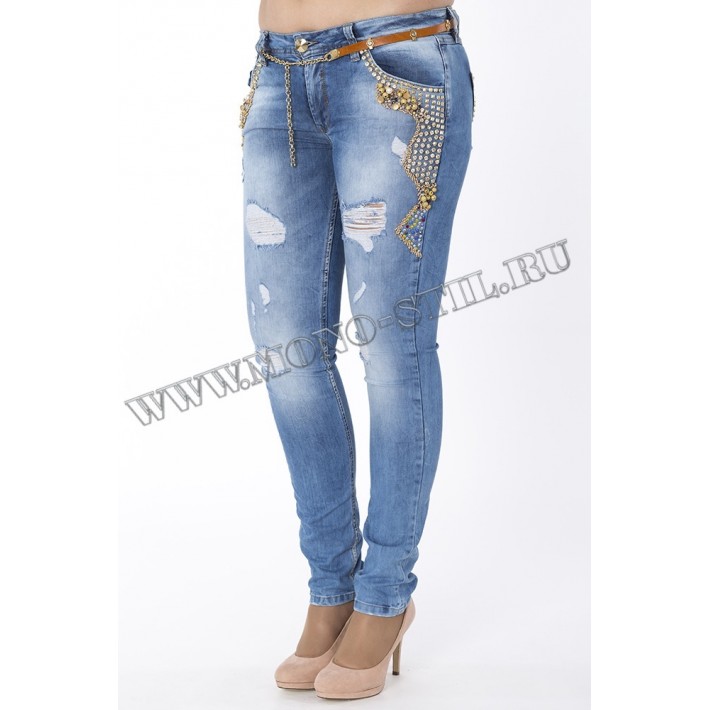
Really cool? I was captivated by the embroidery of large rhinestones and the cute shiny chain on the belt. I had a choice between these:
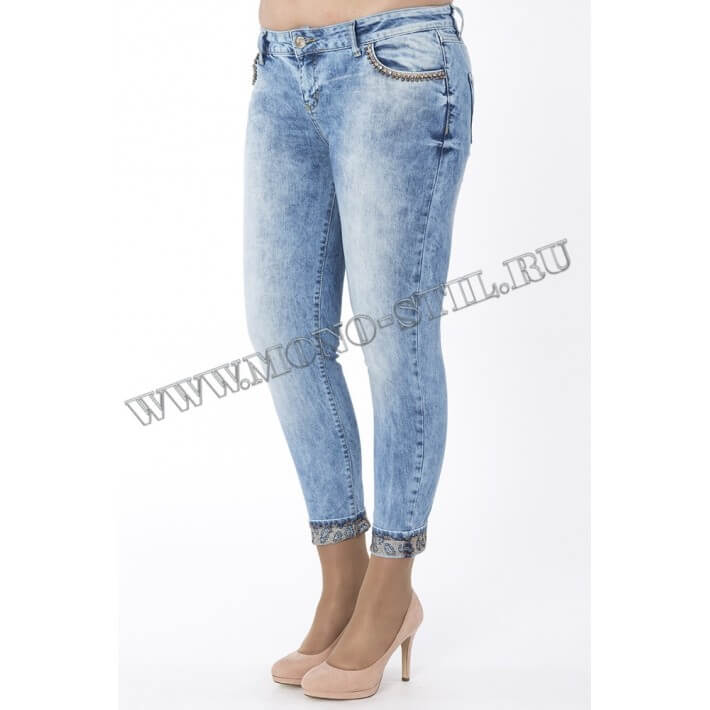
After receiving the update, I immediately shared the super news with my friend. Her reaction surprised me and even puzzled me a little. Ask what? She asked, what kind of boyfriends are these? Did she take her new fan’s jeans off?))) the latter was certainly a joke, but I still had to explain to her how boyfriend jeans differ from others, and what’s special about this model.
Actually, this story gave me the idea: “What if we publish an article and consider all the models women's jeans oh trousers, suddenly, does anyone also confuse the styles and types? Let's bare the topic and bring out all the types and characteristics of these fashionable and irreplaceable clothes.
What are jeans
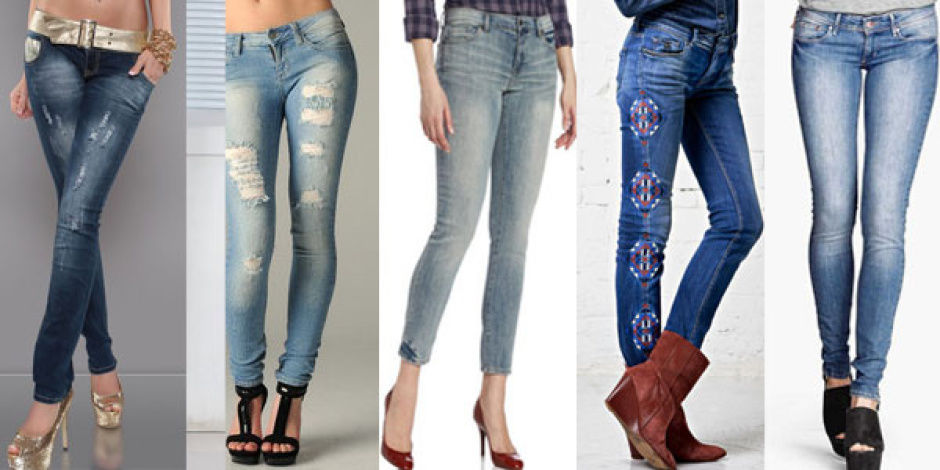
Jeans - a comfortable look casual wear. Every fashionista must have them in her wardrobe. Both men and women wear jeans. They are made from very thick cotton fabric. All seams must be stitched. The first jeans were made by Levi Strauss in 1853 (as you can see, this fashionable look clothes are only 163 years old), he made them as work clothes for farmers. The first products were made from hemp canvas; it was produced in Italy or France.
The real “jeans revolution” took place in the 1960s, more than 100 years after the birth of this type of clothing. By this time, hemp canvas was no longer used for sewing jeans; it was replaced by high-quality cotton. The historical name of this fabric is denim. It was a fairly coarse cotton fabric. It was originally made by the French and “Serge de Nim” translated as twill from the southern French city of Denim. Real French linen was expensive, and over time it was replaced with coarse fabric that was produced in the USA.
IN Lately Women jeans sewn from thick and light denim, elastane and lycra can be added to it, and buyers, in turn, receive stretch jeans that are very soft and pleasant to the body. For winter, jeans manufacturers use insulated brushed fabrics. They are warm even at twenty degrees below zero.
Jeans for ladies differ in cut; each manufacturer has its own classification. Among them are the most common types for the “pear” figure, “ hourglass", "apple", "inverted triangle".
Types of women's jeans: photos, descriptions, characteristics
Regular (classic)fit– a classic, universal look for women’s jeans, this model has five pockets and a straight, relatively loose fit. They are suitable for thin and plump girls with any type of figure. Classic models necessarily present in different seasons of foreign and domestic brands. They are in the spring-summer 2016 collection.
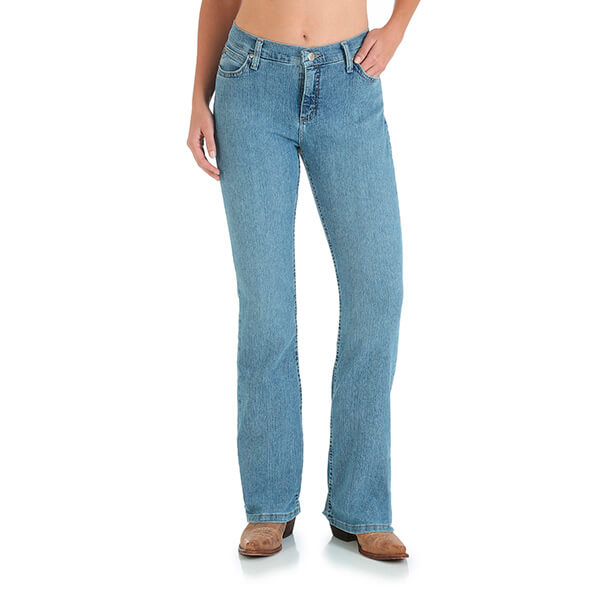 Regular Classic fit - classic jeans for woman
Regular Classic fit - classic jeans for woman RelaxedFit– jeans have a looser fit than the classic representatives of this type of trousers. The model is loose, but not baggy, and has a looser waistline. The small allowance that manufacturers make helps to achieve a slightly casual fit on the hips. Thanks to this, these trousers do not hinder movement. Both young people and mature women love to wear them. The peculiarity of this type of jeans for women is comfort and convenience. They are worn with sneakers of all types, sneakers.
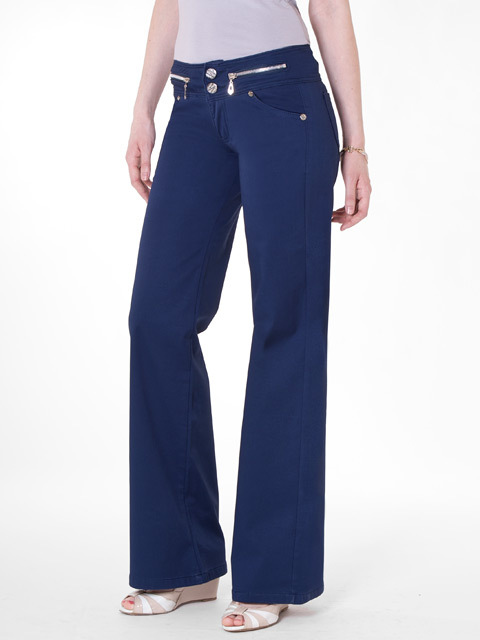
Loosefit (Baggy)– This is a model with a very loose cut. They are suitable for anyone involved in outdoor sports. They are called “tube” jeans. Outwardly they look baggy. Movements are not constrained, they are free along the entire length. But they are comfortable and convenient in any situation. Representatives of street style and hip-hop love the overly loose fit. They are worn with spacious sweatshirts, knitted hoodies, sports jackets, and T-shirts.
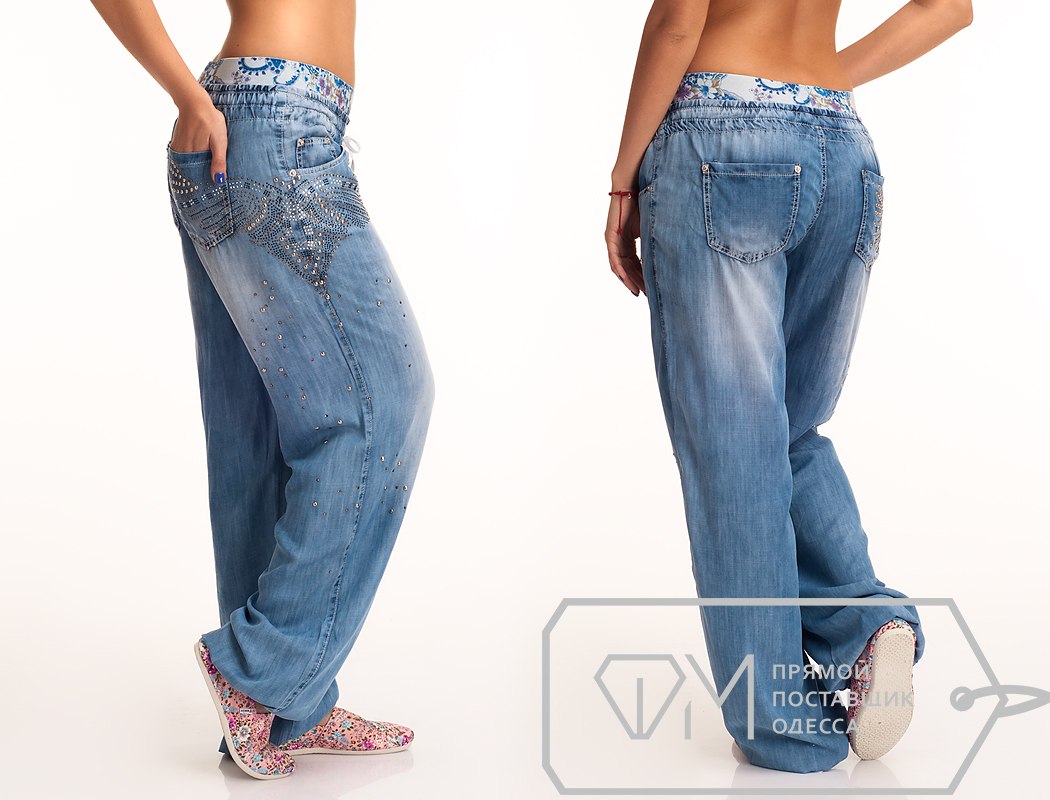
Bootcut— the essence of this jeans model lies in the translation of the name. The word “boot” means shoe, and “cut” means to cross, which means that denim trousers of this type cover the shoes. Another characteristic of this model is the low waistline. The trouser legs are flared below the knee. Bootcut jeans are a popular model among young people. They fit perfectly on any figure. They are worn with jumpers, T-shirts, and dress shirts. Look great with heels.
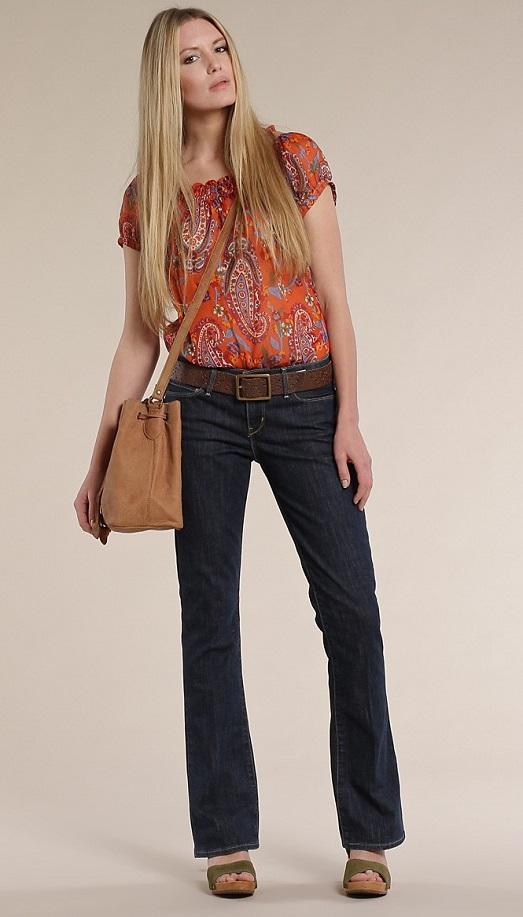 Women's jeans styles: Boot cut in photo
Women's jeans styles: Boot cut in photo Boyfriendfit– strictly female version loose jeans, migrated from men's wardrobe. The style of women's jeans, photos of which are below, is such that it really gives the impression that you borrowed them from your friend. Women's boyfriends have a slightly low waist, loose legs along the entire length, and a lowered groin area. Denim trousers of this type have a minimal amount of decoration, but there may be slits and light abrasions.
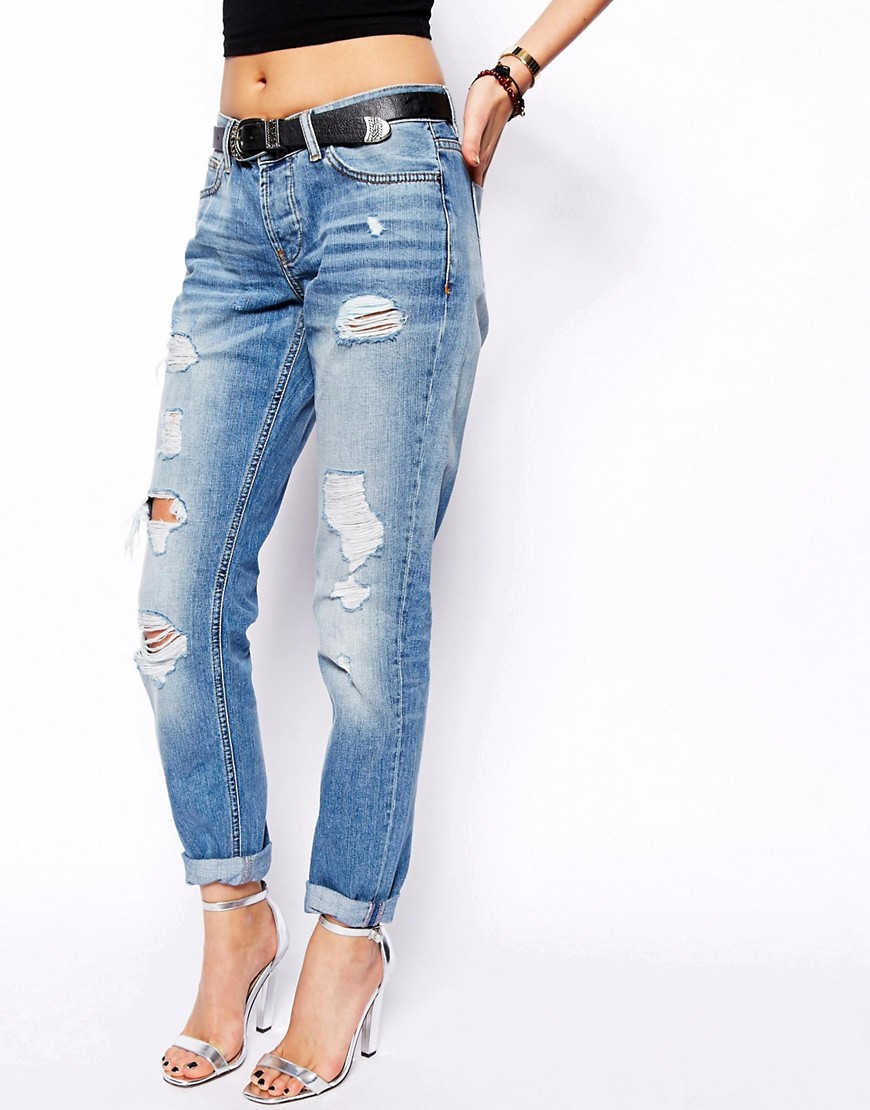 Boyfriend fit - boyfriend jeans for women
Boyfriend fit - boyfriend jeans for women The model looks impressive if you turn the cuffs up. Women's boyfriend jeans are recommended for girls with an inverted triangle body type. Their cut compensates for narrow hips and creates visual balance with broad shoulders. Such models are not suitable for ladies with an apple and pear figure; it is better for them to choose jeans of a different cut. They occupy top positions in the wardrobe of every fashionista. Their advantage is that they perfectly emphasize the advantages of the figure.
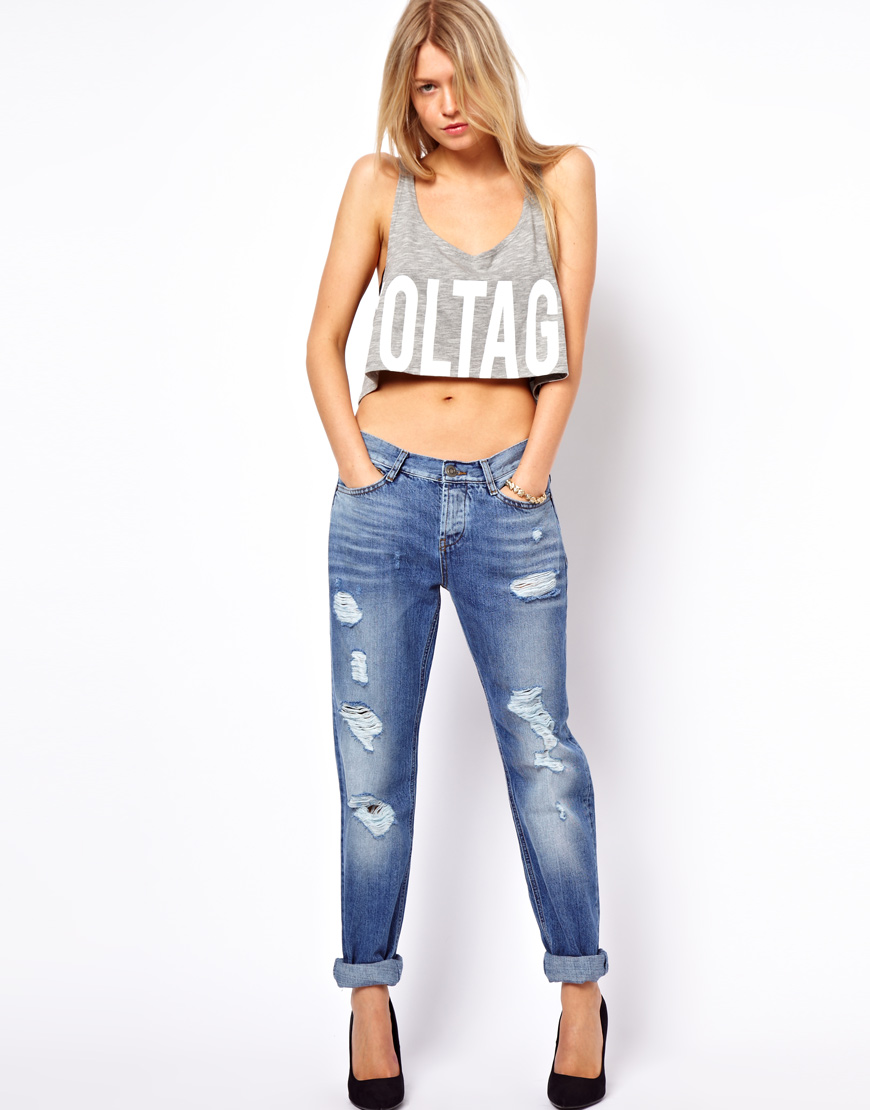 Boyfriends with cuffs rolled up
Boyfriends with cuffs rolled up Slimfit- a model of women's jeans that fits exactly to the figure. Recommended for fit, slender and tall girls. Slim jeans are not suitable for ladies with curvy figures. They are made from dense stretchable fabric. Most often, products of this type have a low waist, thanks to which they have an excellent fit on the hips.
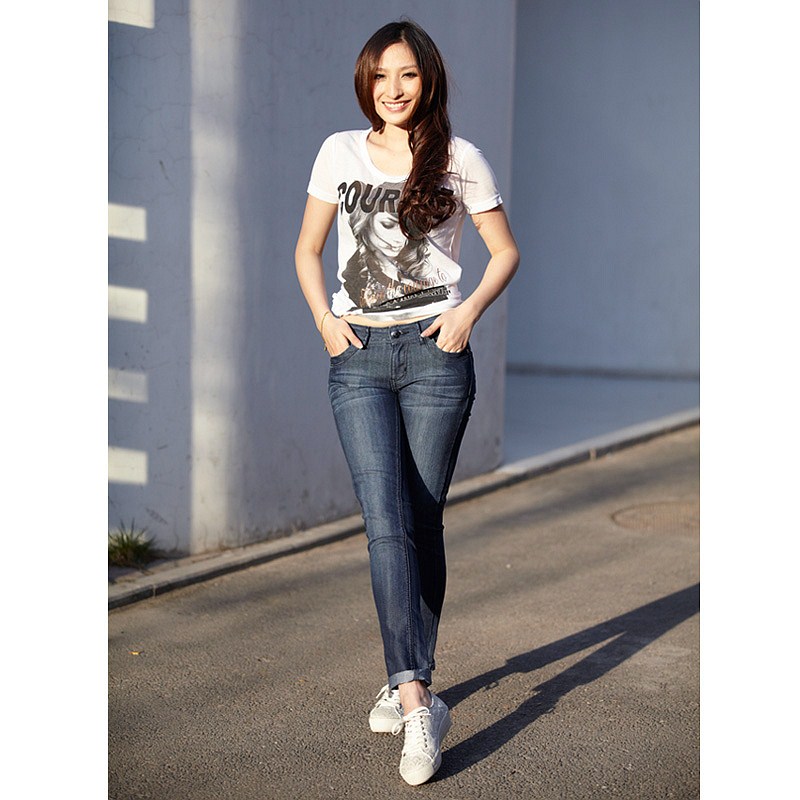 Slim fit - slim jeans for women
Slim fit - slim jeans for women 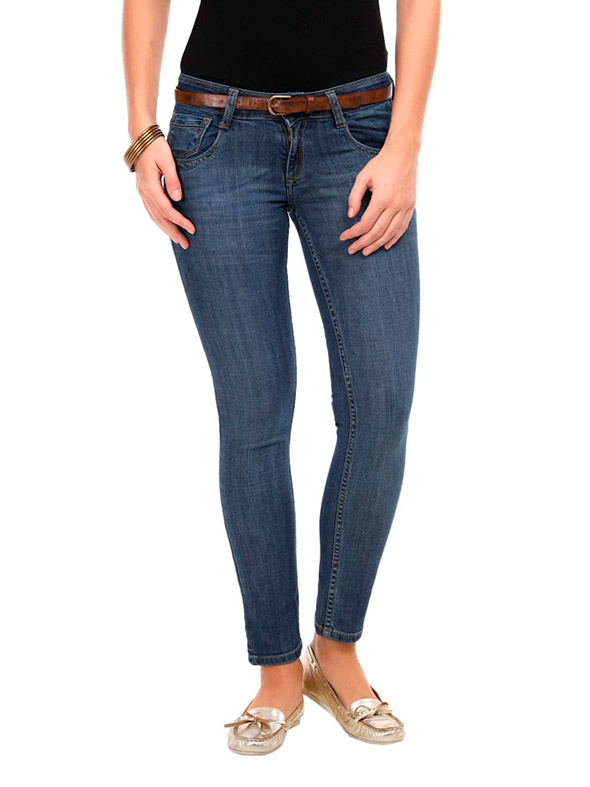
Skinny– jeans of a narrow cut, tight-fitting. Their name is “second skin”. They are very tight and hug the body and hug the figure. This style is recommended for girls with nice shapes, they are not for thin people. They are made from thick fabric, which stretches and fits the body well. The material contains lycra. The peculiarity of the model is to add leg length. These types of women's jeans have a high waist. Initially, tabernacles were a women's model, today there are such jeans for the male half of humanity.
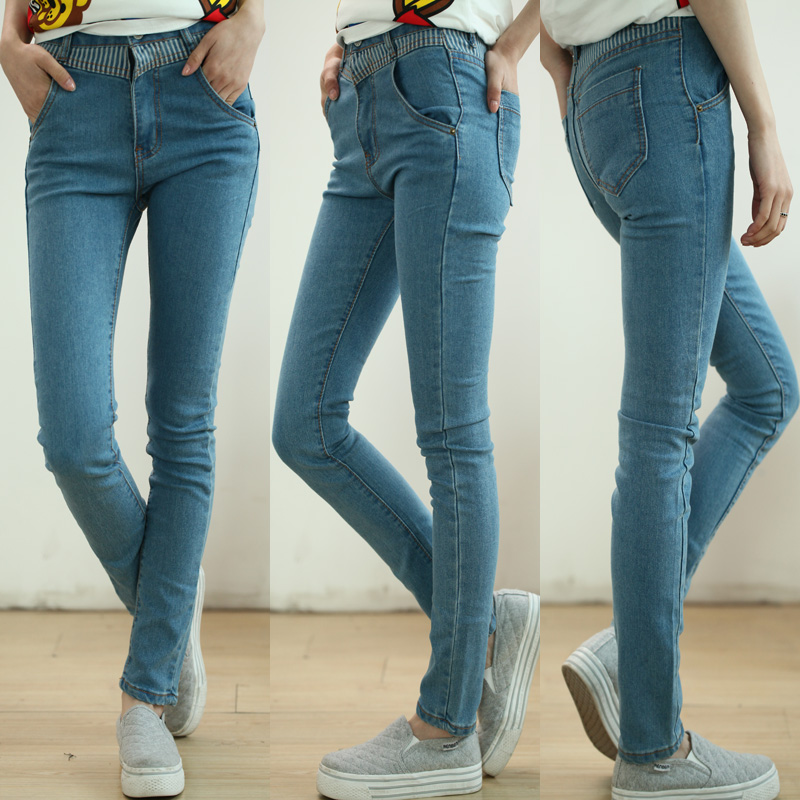
Twistedjeans– jeans for women with an offset side seam. This model of denim trousers is suitable for girls with full legs. Their peculiarity is to visually slim the silhouette and lengthen the legs. It is recommended to wear twisted with tunics and heeled shoes. Products in dark blue and black help to shape your figure and hide excess weight.
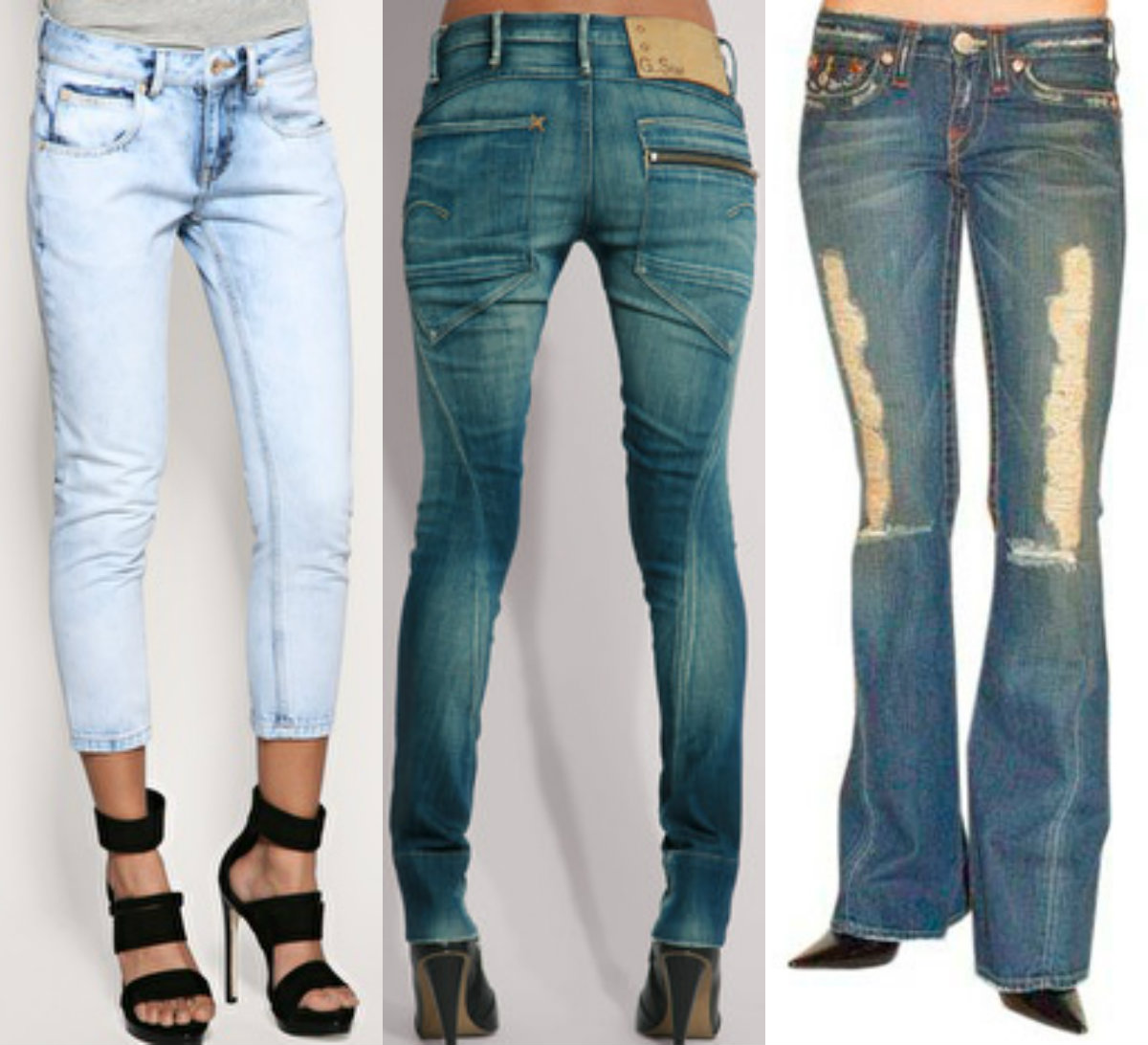 Twisted jeans - twisted jeans for women
Twisted jeans - twisted jeans for women Jeggingsfit– very skinny jeans for women made of stretch fabric, these are the narrowest models. The fabric contains elastane. The colors of jeggings for women are very different: blue, black, gray, beige, white, “boiled”. Jeggings for women are made from thin elastic denim with an imitation denim pattern. This is a cross between skinny jeans and leggings. It clearly follows the shape of a woman’s figure and fits close to it. Jeggings have a soft elastic waistband with or without a fastener. The belt can be decorated with rhinestones, fringe, buttons and other decor.
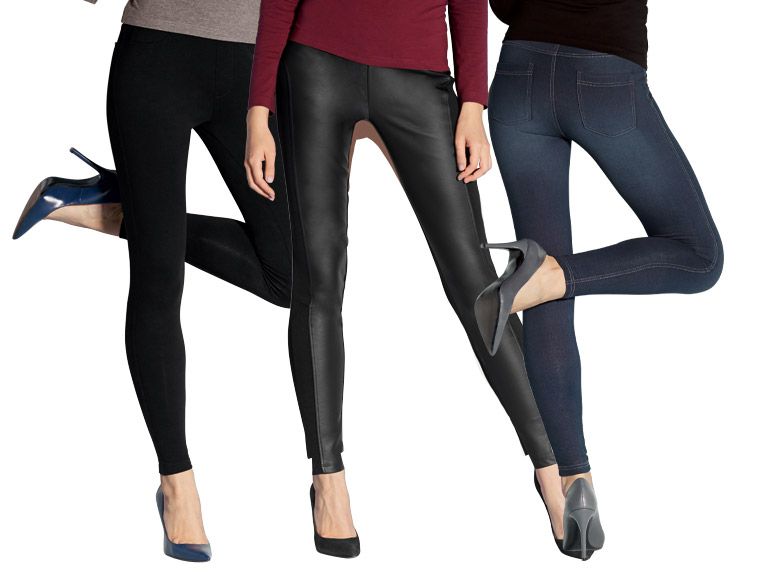 Jeggings fit - women's jeggings
Jeggings fit - women's jeggings 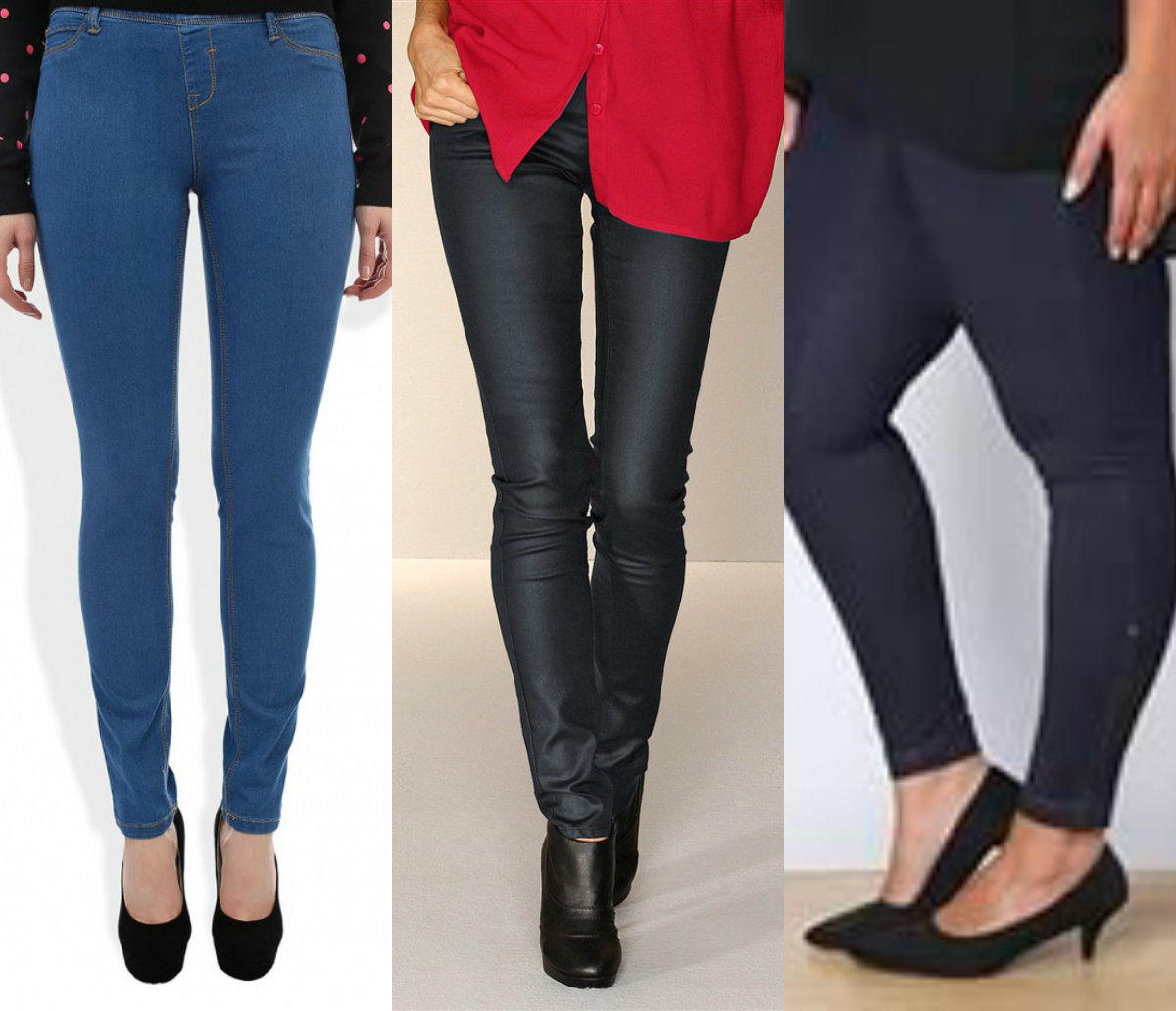 Jeggings fit - women's jeggings for overweight and thin women
Jeggings fit - women's jeggings for overweight and thin women All descriptions and photos of types of women's jeans will help you learn to navigate the variety of models and styles presented in store windows. The choice of jeans for overweight ladies, like the one, must be carried out according to certain rules (we’ll talk about them a little later). And also in order to create a stylish fashionable image you need to learn how to choose the right top and shoes for them.
Shopping online in foreign stores certainly provides a person with a huge choice. However, such diversity can often puzzle even sophisticated buyers. When choosing “remotely” a product such as jeans, a person will inevitably encounter an abundance of specific terms and designations. "Boot cut", "tapered leg", "relaxed fit" and much more. Sometimes dealing with this can be quite difficult. In addition, a person, wanting to buy, for example, classic straight-cut jeans, will not be at all happy about the prospect of purchasing something that is absolutely suitable for him in size, but completely inappropriate in style (for example, jeans with a normal size in the waistband will turn out to be too narrow or, on the contrary, wide). Therefore, today we will try to clarify some questions that usually arise when choosing jeans.
It is worth considering the main characteristics regarding style and fit, as well as examining the terms by which they may be designated in certain online stores.
The word "FIT" refers to the overall silhouette of the jeans. How wide or narrow the cut will be depends on this characteristic.
This is the most basic characteristic of jeans, their “skeleton”, so to speak, and it is this parameter that can primarily determine how adequately certain jeans will look on a particular figure of their owner.
The most common for jeans is the so-called "Regular fit". Sometimes this fit can be called "Classic fit". In this case, the silhouette of the jeans does not fit very tightly on the figure, but at the same time, such a silhouette cannot be called spacious.
Almost every manufacturer involved in sewing denim clothing makes jeans of a similar fit. With this cut, the fit is quite snug in the hip area, but by no means a tight fit, and at the same time it is not a baggy fit.
In general, when “classic jeans” are mentioned in the description, then, as a rule, we are talking about Regular Fit. The most typical “representative” of such a fit can be called the well-known Levi’s 501, as well as dozens of models from various companies, one way or another based on the silhouette of the famous “five hundred first”.
This silhouette suits most body types. Regular fit fits well overweight people(he even slightly “slims” them, without making you convulsively suck in your stomach), such jeans also don’t hang like a bag on thin people and, of course, he looks good on people with a standard figure.
Regular Fit will look adequate on both older and younger people. You can combine jeans of this cut with classic shoes, as well as sneakers or sneakers. Concerning outerwear, then everything here is also quite universal, it will look good with both short jacket, and with a voluminous winter parka.
This cut can be characterized by a more relaxed, loose silhouette (as the name suggests). At correct selection size, such jeans, as a rule, should not have a tight fit at the hips. Moreover, some manufacturers sometimes add some “allowance” for a more natural and slightly “casual” fit. This is where the opinion sometimes comes from that some jeans of this cut are too big. In other words, jeans with a Relaxed Fit silhouette tend to fit similarly to informal casual pants with a loose, but not baggy, fit.
For example, Levi's 559 relaxed fit jeans have this fit
Based on the practical side of the issue, such a fit will be good for people for whom a classic regular fit will be too tight in the hips. For example, many people involved in weightlifting or powerlifting sometimes find it difficult to choose clothes for themselves precisely because of their developed quadriceps. In this case, a relaxed fit will be very good choice. Also, this cut is good for a person who wants to have some relaxation when choosing the appropriate style of clothing. A day off, a walk in the park with children, a trip to nature - all this may require some physical activity, and, therefore, clothes that do not restrict movement. In this case, these “relaxed style” jeans will come in handy. These types of jeans are also good to use in winter, especially if they are made of thick denim. Firstly, it is very convenient to wear thermal underwear under such jeans, and secondly, they are very harmoniously combined with a voluminous “top” in the form of winter warm down jacket. Shoes with such jeans will look good with the now popular massive work boots like Red Wing boots, various modern adaptations of trekking and hiking shoes, as well as all types of sneakers and sneakers.
A similar jeans silhouette can be characterized by words such as “baggy”, “loose”, “casual”, etc. Sometimes the manufacturer may use terms such as “Baggy Fit” or “Antifit” for such a fit. This is a very spacious cut that does not restrict the wearer’s movements at all. It is no coincidence that this silhouette is very popular with various streetwear brands, one way or another associated with active street sports. For example, manufacturers such as Carhartt, Addict, Boxfresh, etc. always have jeans of such a loose, baggy cut in their collections.
Please note that such jeans can not only have a very wide cut, but also have a significant margin in the waistband. So be careful when choosing the size.
Loose fit is primarily suitable for active, athletic youth. These jeans are best paired with sports or street style clothing. Comfortable knitted hoodies, spacious sweatshirts, T-shirts, Blazers- all this will go very well with loose fit jeans. As for shoes, all versions of sneakers will look good, up to the rather bulky “basketball” options.
Women have their own version of these baggy jeans, the so-called boyfrend fit. This is not to say that it is a very popular thing, but many people like it.
It's a fairly narrow fit. These jeans fit exactly to your figure, but are not overly tight. This fit has a very tight fit at the hips. Sometimes new jeans with a similar cut are not so easy to put on, and at first they can be a little tight and quite uncomfortable to wear. It's okay :) Everything is as planned, in just a couple of hours the new skinny jeans will fit perfectly and will no longer be a source of discomfort. Slim fit is the true embodiment of rock and roll. Let's remember old photographs of rock stars, fit “music idols” were certainly dressed in just such skinny jeans. There is really one “but”. For these jeans you need to have a slim, toned figure. If a person has a plump figure, such jeans will only highlight its flaws; in this case, it is better to look at a regular or relaxed fit. It is best to combine skinny-cut jeans with the same slim-fit clothing that fits tightly to your figure. For example, with such jeans, tight T-shirts, tight-fitting formal shirts, mismatched jackets with a fitted “Italian” cut will look good, and classic polo shirts of the same narrow silhouette will look most advantageous.
Slim fit jeans go well with classic shoes, but if you combine them with any variations sports shoes, then it is better to use minimalistic “low-tech” sneakers from the so-called “retro classics”. Canvas sneakers from a variety of manufacturers will also look good, or, in some cases, yacht shoes or moccasins will be a good option.
Outerwear with slim fit jeans will include jackets, peacoats and coats of a semi-fitted silhouette. It is better to avoid a voluminous “top”, since a slim “bottom” may not contrast with such clothes in the best way.
Just as the loose fit is a kind of extreme version of the relaxed fit, the skinny fit is an extreme exceptional version of the “slim” fit. Jeans of this fit have an extremely narrow cut that fits along the entire length of the leg, like a “second skin.”
In general, when people talk about skinny, they often mean the silhouette of jeans for the fair sex, but over the last few years skinny has been actively used in men's jeans. There are a lot of prejudices on this score, but personally I think that there is nothing reprehensible in such jeans. Skinny fit is a legacy of the punk rock of the rebellious 70s, which later took root, to some extent, in skate culture. In the 90s, such jeans were an attribute of the so-called “heroin chic”, the reason for this was the film Trainspotting with Ewan McGregor in leading role.
Thus, skinny fit jeans and Converse sneakers have become an invariable combination, emphasizing the somewhat deliberately “decadent” style of the owner. This is the most common and traditional kata. In its original understanding it looked like this. The trouser leg had a completely straight cut, unchanged from the knee itself. This is roughly what jeans looked like in the 50s, a straight, completely non-tapering silhouette. If these jeans were a regular fit, a completely straight leg would visually increase the width. Therefore, for example, Levi's replicas from the 50s often look like quite roomy jeans, although their hip width may not exceed the same width as modern 501s.
If the jeans have a slim fit cut, a completely straight leg can create a visual image of some flare.
Similar jeans are still produced today, but they are relatively rare and, as a rule, from manufacturers who are inspired by the heyday of the denim industry of 40-60.
Currently, jeans, referred to as straight cut, are made somewhat differently. Following the anatomical structure of the human leg, the trouser leg from the knee has a very slight narrowing (but just a slight one, otherwise it is no longer a straight cut). This is exactly what the most classic pant leg shape looks like from dozens of different manufacturers from around the world. This cut goes great with a wide variety of shoes and is generally very versatile. These jeans look good both rolled up (this is a legacy of the era of the same 40-50s) and adjusted to the required length. The most typical example would be the same image of the same 501 Levies.
This is a tapered fit, sometimes the term " tailored leg", which quite accurately reflects its essence and origin. The fact is that in the 60s there was a fashion for stitched trousers, which were narrowed by tailors in the studio or people sewed trousers and jeans on their own. Soon such jeans began to be produced in factory versions Sometimes the leg opening (bottom of the leg) of such jeans is so small that you can barely stick your foot in. Thus, if we talk about tapered cut, we are talking about tapered jeans that have a pronounced bevel from the knee. Such jeans require a good figure, therefore It’s still worth imagining how good they will look on the owner.For shoes with tapered cut jeans, you should use neat, not very bulky shoes, for example, sneakers based on retro classics or completely minimalist sneakers like classic Vans or Superga.
It should also be mentioned that if these jeans are made from selvedge denim, the “hem” is usually cut off due to the indirect tapered patterns of such jeans.
The bootcut is a legacy of the cowboy era of the wild west. A practical feature of these jeans was the ability to wear them over cowboy boots. Also, if necessary, such jeans could be easily rolled up to the knee; with a straight cut, such manipulations would be difficult to do.
To put it very simply, a boot cut is flared jeans that widen towards the leg opening. There are several options for this cut. The most common option is when the trouser leg in the knee area is “fitted” on both sides, while the bottom of the trouser leg has approximately the same width as in the hip area. This is a rather “delicate” option, when the flare falls quite unobtrusively onto the shoes, without being very noticeable. A more “extreme” option is a pronounced extension from the knee (socket). In this case, the bottom of the trouser leg is clearly wider than the thigh. Sometimes a term such as Flared Leg is even used, i.e. obvious, pronounced flare. Remember the photographs of hippies from the 60s - these are exactly these jeans.
Currently, this option is rare and is intended for very big fans of such aesthetics, despite the fact that the bootcut is not the most trendy cut at all. Sometimes there is, so to speak, a “one-sided” bootcut. In this case, the outer side of the trouser leg will be absolutely straight, and the inner side will just have a slight expansion downwards. Sometimes these jeans can look even closer to a straight cut. This is exactly the cut of the iconic jeans from the Swedish company Nudie, the Regular Ralf model (later renamed Alf), for the last seven years. Straight cut for outsim and very slight bootcut for inside. At the same time, the famous selvedge edge for this reason remained completely untouched and was often shown on the hem.
Who are flared jeans good for? First of all, such a kat can be recommended to people with large size legs. Imagine a person with shoe size 45 wearing skinny jeans. Introduced? So, in the case of a boot cut, the large foot will be visually “balanced” by the flared leg that naturally falls onto the shoe. These jeans look good with sneakers (again, for some this may be a “return to the 70s”) and almost any sneakers from the simplest adidas gazelle to runners from NB or Asics.
This term denotes, in the language of tailors, the “seat height” of a thing.
That is, how high, low or medium the landing will be depends on the Rise parameter. There are High Rise, Medium Rise and Low Rise.
This is a high-slung style, much loved by cowboys. Most characteristic image for the Wrangler, it's a tight fit with very high-rising jeans. The fact is that this is dictated by the specifics of horse riding; with a lower waistband, the pants will simply slide off the wearer. Cavalry trousers also had a fairly high rise for the same reason.
If these jeans are fastened with "bolts" (metal buttons), they may have one additional "button".
Jeans with a high waist look better on a standard figure (eg. full person such a belt will simply be inconvenient).
Current fashion trends dictate slightly different standards. However, if a person really likes such a fit, of course, no one bothers him to use it to his heart’s content.
The most common "medium fit". The most typical medium rise jeans are, again, the traditional 501 Levi's. However, this only applies to modern 501s. Historical Levi's 501s often had a rather high, almost Wrangler-like belt. This is especially true for models of the 44-47s. Just look at modern replicas of jeans from this period or Levi's own "reconstruction" LVC line to be convinced that the seating position of such gins was quite high.
Jeans with a Medium Rise fit naturally - neither high nor low. Medium Rise is suitable for absolutely everyone - fat, thin, and average; both youth and older people; both men and women.
Low Rise is a low belt. This type of planting gained popularity in the 60s. It can be “slightly below average” or very low, when the jeans sit very low on the hips (the latter is typical primarily for women’s jeans). This fit is also very much for everyone; people accustomed to the classics may not find it too comfortable. However, many people and especially women like the fit of their jeans.
Thus, we found out that for full description When cutting jeans, three main parameters are used - these are Fit (the overall silhouette of the jeans), Cut (the width of the pant leg from the knee to the bottom) and Rise (the height of the waistband). Now we can easily understand any description of jeans in online stores (and perhaps in a regular store the description that previously seemed like “Chinese writing” will be much clearer).
For example, if we read in the description: regular fit - boot cut - low rise, then we can easily figure out that we mean jeans of a classic “medium” silhouette, with a slight “flare” at the bottom and a low rise in the waistband. Slim fit - medium rise - tapered cut - these are skinny fit jeans with a medium waist and tapered at the bottom. High rise - relaxed fit - straight cut - these are jeans with a high waist, a spacious silhouette, and a straight leg (i.e. something similar to Wrangler jeans or any “working” style jeans).
Jeans appeared in the mid-19th century, first appreciated by gold miners and then by cowboys. A century later, jeans conquered the whole world, and, probably, there was not a person left who would not try on jeans.
However, not all jeans are created equal. For you. It has probably happened to you that some of them are comfortable for you and you can wear them without taking them off, while others are kind of bad and don’t fit well. First of all, we blame the manufacturer (and sometimes this is the case), but most often the reason is that the second model does not suit you.
To avoid wasting time in fitting rooms, you need to understand what types of jeans you like. And then every seller will understand what kind of jeans you need, if you name the style.
Despite the fact that fashion trends change incredibly quickly and each manufacturer has its own labeling and classification of denim, all jeans are in one way or another derived from classic and widespread models.
I spent a lot of time compiling a classification of types of jeans and am happy to share them with you. So, jeans differ:
- by type of fit (how high the belt is);
- by silhouette (straight, tapered, flared);
- by degree of fit (narrow, loose).
Each model combines two or all three features, resulting in many variants.
Jeans: types of fit
Low Rise Jeans(low waist) and Ultra Low Rise Jeans (very low rise) are difficult to distinguish, the line between them is quite subjective. Fits well on petite girls, emphasizing graceful figure and a narrow waist. 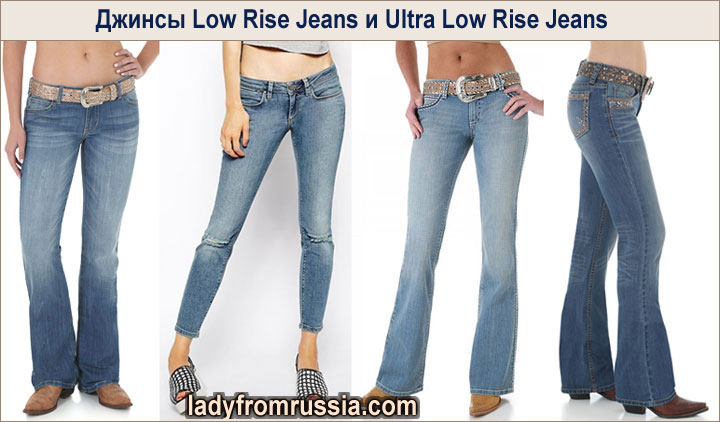
Mid Rise Jeans(Mid Rise Jeans) are universal and suitable for everyone. Most models are just like that.
Jeans with high waist
(High Rise Jeans) perfectly lengthen the legs - they fit especially well on tall, slender girls. 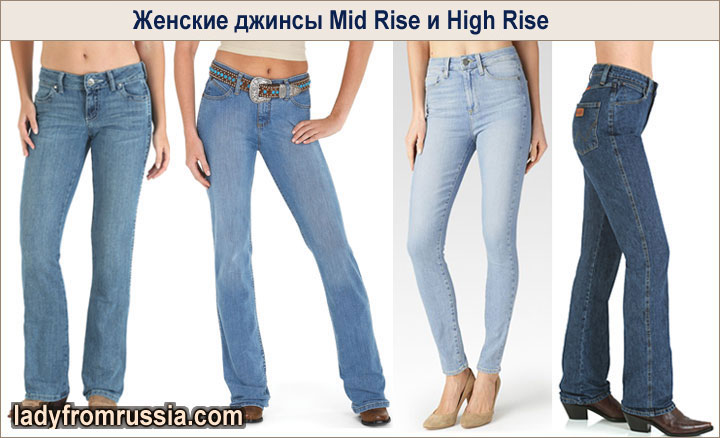
Jeans: types of silhouettes
(straight) are suitable for absolutely everyone due to the fact that they have a straight cut and fit the figure quite loosely, without drawing attention to the waist, stomach and hips. The shape of the legs is almost straight. However, straight-edge women's jeans are extremely rare; if such a marking is present, it is most likely the Basic model. 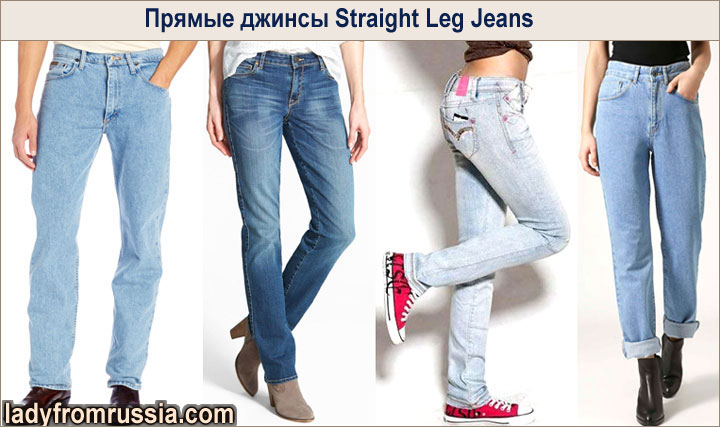
Basic Jeans These are classic jeans. The very ones with which it all began. They should not be confused with the Straight Leg model: Basic jeans have legs that are not straight, but slightly tapered at the bottom. Based on them, manufacturers produce a variety of models in accordance with fashion trends(eg Regular Fit). The beauty is that two or three sizes will suit you at once - with varying degrees of fit. 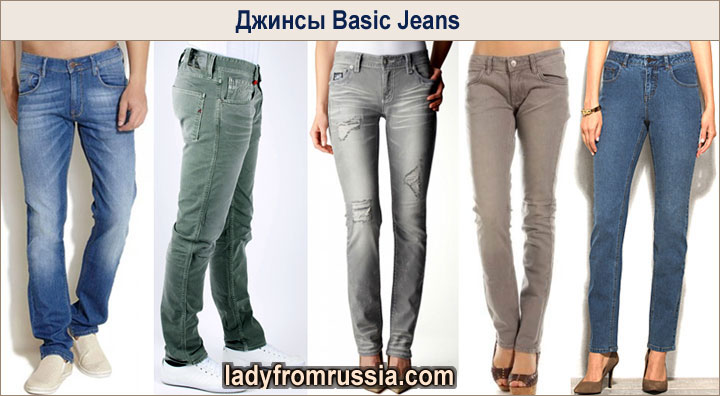
Bootcut Jeans straight silhouette, slightly flared towards the bottom - they sit tightly, hug the legs in the upper part, and slightly widen from the knee. This model remains one of the most popular, regardless of fashion trend.
Flare Jeans (Flare) are a variation of the Bootcut style; they are tight-fitting at the top, covering the knee, and wider at the bottom. 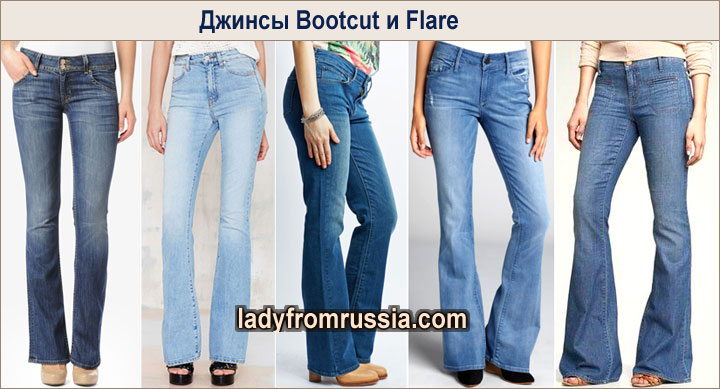
Trouser Jeans ( Trouser style) are denim trousers. Women's Trouser models are tight-fitting at the top and widen from about mid-thigh.
The Wide Leg model appeared quite recently. These are very loose Trouser or Loose flare jeans - very flared jeans that begin to widen from the hip. In the 70s, such styles were extremely popular, because bell-bottoms dominated fashion for almost 10 years: the wider, the better. 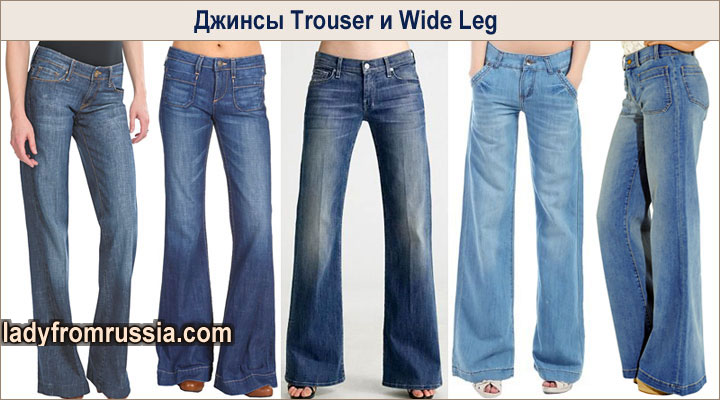
Jeans: types of fit
Skinny- these are skinny jeans, translated as “second skin”, “skinny”, “tight-fitting”). They repeat the silhouette of the figure, hugging the legs to the very bottom. They fit well only on those with slender legs.
Jeggings - leggings styled like jeans. At first glance, these are the same skinnies, but there is a difference. Skinnies are made from thick denim, and jeggings are made from elastic stretch fabric, which looks like thin denim. Jeggings are often decorated with decorative inserts and all sorts of things. 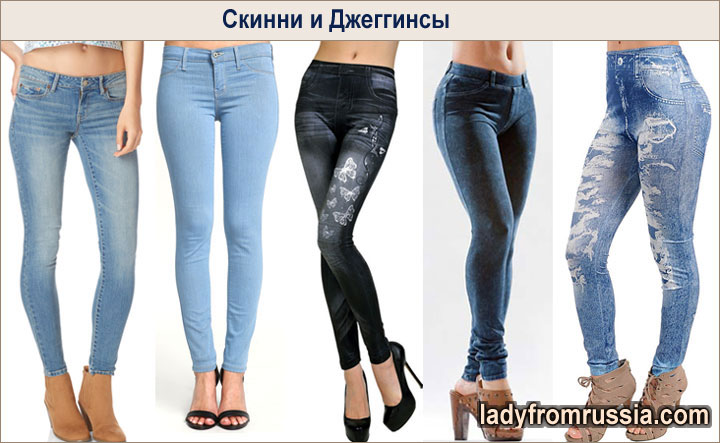
Loose Jeans look like Straight Leg or Basic big size. However - attention! - their belt fits well, and the pants will not slide down without a belt. Most often this male models, since girls prefer tight-fitting or straight “boyfriend” jeans. 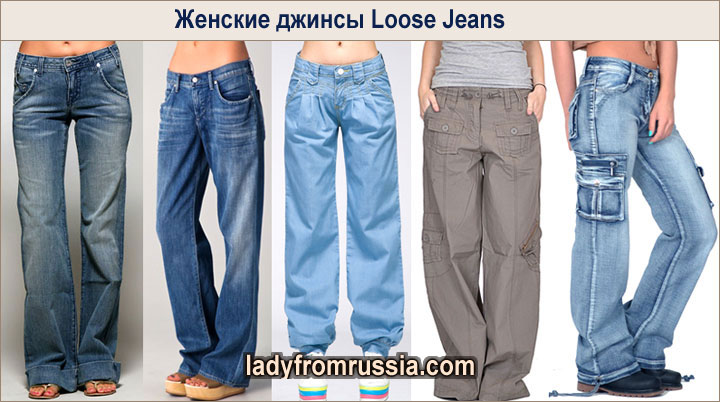
(Boyfriend Jeans) - loose, often torn and loose. They are usually rolled up slightly at the bottom, as if they were too long - that's why they are called "boyfriend jeans." 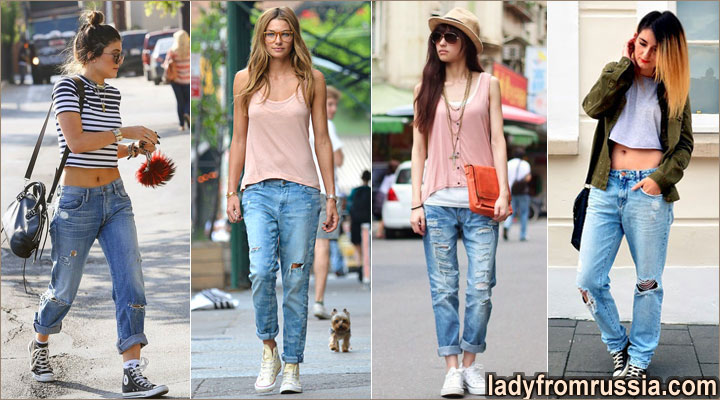
Girls fell in love with them for their comfortable fit, because walking around in classic or skinny ones gets boring.
Suitable for those who like to dilute a strict look with a casual accent. This is the highlight of “boyfriends”. They look ideal on tall, narrow-hipped girls, as due to their baggy hips and straight cut, the legs add volume to the figure.
Well, now it’s time to take out your favorite jeans and determine what they are. Now you will know exactly why you loved them. And in the next article, read how to choose jeans according to your body type.
Popular new products, discounts, promotions
Reprinting or publication of articles on websites, forums, blogs, contact groups and mailing lists is NOT allowed

Jeans are one of the most comfortable, wearable and versatile items in a modern wardrobe. The abundance of colors and styles presented makes it possible to make jeans an integral part of almost any style. Of course, provided that they fit their owner perfectly. Meanwhile, purchase a high-quality branded item at affordable price Nowadays, you can buy clothes mainly in online stores, which means you often have to make a purchase without trying them on.
How can you avoid getting into trouble and, based solely on the description and characteristics of the product, “in absentia” buy jeans that fit your figure? To do this, you should learn to be well versed in the sizes, models, styles and some other features of this type of clothing.
Jeans cut
The cut of jeans is characterized by three main dimensions: silhouette (English fit), height (English rise) and width of the leg (English cut).
1. Silhouette
This is the main characteristic of the style, expressed in how tightly the jeans will sit on their owner. The silhouette can be very tight-fitting - skinny, narrow - slim, medium - regular, loose - relaxed, spacious-baggy - loose.
Skinny fit
This cut is the narrowest of the existing ones, and along the entire length of the product. At first, this silhouette was used to create mainly female models, but nowadays extremely tight jeans can often be found on men. In fact, this fit is perfect for unisex styles. Skinny fit is especially popular in youth denim collections famous designers. In combination with stylish sneakers he creates a somewhat defiant image of a bright and dynamic person, not limited by any dress code. It should be noted that this silhouette does not look good on every figure, so before purchasing skinny jeans it is recommended to really evaluate individual characteristics your physique. We should also not forget about the significant inconvenience associated with putting on such jeans, as well as some stiffness when moving.
Slim fit
Also a tapered cut, but more “forgiving”. Slim jeans are figure-hugging, but not overly flattering. They fit perfectly slim people of both sexes. Women can combine a fairly voluminous top with them, while men are better off choosing tight-fitting T-shirts and shirts, skinny designer jackets, classic or sports jumpers, narrow jackets and short coats. Shoes will fit as sporty style, and casual.
Regular fit
The most popular and, without a doubt, universal cut. Quite a tight fit in the waistband and a straight semi-fit along the entire length of the leg. The advantage of jeans with a regular silhouette is that they fit very well on almost any figure, slightly tightening it and at the same time not restricting movement. This is an eternal classic that does not go out of fashion, an example of this is the legendary Levi's model 501. Regular fit is preferred mainly by middle-aged people, however, young people do not ignore them, especially appreciating the fact that they can be combined with any top - like a tight-fitting one , and free. In everyone's collection famous manufacturer There are always several models of jeans with a classic cut, namely regular.
Relaxed fit
Loose-fitting jeans that do not restrict movement at all, suitable for everyday wear outside the office, for a relaxing pastime and relaxation. The loose fit along the entire length of the product even creates a feeling of being somewhat oversized, but this is precisely the effect that was originally intended in the style. Most people use relaxed jeans exclusively for active work, trips to nature or walks with children and pets. It is very convenient to wear an insulating layer of underwear under relaxed fit jeans, which is why they are more popular in winter. However, some men and women of heavy build, whose regular cut is too tight on the hips, wear relaxed fit jeans every day at any time of the year. This option is suitable, for example, for athletes with prominent leg muscles. The main thing is to choose the right top that suits your style. This could be a voluminous jumper, a spacious jacket, or any clothing that has a slight overlap just below the waist. Shoes of any sporty style are suitable, as well as trendy models with chunky soles. Classic example The cut described is Levi's 559.
Loose fit
Super roomy fit, even a little baggy. Jeans of this silhouette look rather casual, so they are subconsciously associated with modern “street” subcultures, whose representatives mostly prefer this style. A loose style is often combined in such models with a low rise, which creates an even greater feeling of deliberate negligence. Loose fit is worn mainly by young, active people with creative thinking. This cut looks especially shocking on girls, but in some cases we have to admit that it can be appropriate - for example, if you have a non-standard figure. There is even a special name for the silhouette of women's jeans with increased windage - boyfrend fit, ironically hinting that the fashionista probably borrowed this piece of clothing from her boyfriend. The terms “Baggy Fit” or “Antifit” can also be used to refer to this cut. When purchasing jeans of this style, keep in mind that their width at the waist is fully consistent with the baggy style, that is, it will not emphasize the waist. When purchasing, be sure to find out this parameter, otherwise you may end up with your jeans simply falling off.
2. Landing
Rise is determined by the level at which the waistband of jeans is located in relation to the person’s waist. There are high rise (high), medium (medium) and low rise (low).
High rise
Jeans with a high waistband. Initially, they were conceived for the convenience of riding, so as not to move off the back of its owner when he sits for a long time. To wear this style, a person needs to have at least a defined waist. Accordingly, people with full figure it doesn't fit at all. Nowadays, high seating is considered a thing of the past. fashion trends, however, many adherents of the cowboy classic are still faithful to it. Jeans with a high waist often have not one button for fastening, but two. If the entire fastener consists of metal buttons, their number is increased by one piece compared to medium rise.
Medium rise
Medium landing. The most common option, it fits well on almost any body type and fits any jeans silhouette. Most traditional regular fit models have this fit; it is preferred by self-sufficient, balanced people who are calm about fashion trends. The mid-rise is universal, it does not interfere with either moving or sitting, it visually improves the figure and goes with any clothes.
Low rise
Jeans with a low waistband that sits at the hips. Such models are preferred mainly by women - in combination with a tight-fitting top, they emphasize the naturalness and flexibility of the figure. However, there is also a second side to the coin - sitting and actively moving in such jeans is extremely uncomfortable, unless you set out to show off your underwear to those present. In addition, low-rise jeans are not suitable for the cold season, because... do not protect the sensitive lower back area from low temperatures.
3. Leg width
This parameter does not indicate a linear value, but the cut of the trouser leg from the knee area to the bottom of the product. This silhouette is designated by the terms tapered (tapered), straight (straight) and boot (flared).
Tapered cut
Tapered leg. In the middle of the twentieth century, products of this style were not produced, therefore, when the fashion for tapering models arose, its supporters on our own brought their trousers in line with new trends by simply sewing them in. This is where the second name of the cut comes from - tailored leg. After some time, factory production of jeans with tapered cut was organized. Note that when purchasing them, you should realistically assess your chances - you must have relatively beautiful and slender legs for tapered jeans to fit well. The top for them can be either tight-fitting or loose, depending on your body type. As for shoes, they should not be too massive. Sneakers or light sneakers are perfect.
Straight cut
Straight leg cut. The most popular, universal and even somewhat conservative option. Despite the fact that the cut is considered straight, in fact, it is not straight at all, but a carefully thought-out anatomical shape that repeats the smooth curve of the human lower leg, due to which it looks good on legs of any length and fullness. Although once upon a time, more than half a century ago, “straight cut” meant straight, strictly according to vertical line. Nowadays this is almost never practiced. It should be noted that the straight cut leg cut is used in models of almost all silhouettes, and not just regular fit. These jeans are suitable for any shoe - both sports and classic. By the way, this is the only cut that will look stylish even with the trouser leg rolled up.
Boot cut
Jeans with legs that widen at the bottom. It is believed that this is what the first cowboy jeans were like - they could easily be rolled up if necessary and went well with chunky shoes. Unlike the tapered and straight silhouettes, which are presented quite clearly, the boot cut has a lot of variations, ranging from pronounced bells (Flared Leg) and ending with a discreet flare on only one side of the leg, when the width of the bottom does not exceed the width at the hip (option famous model Regular Ralf from Nudie, Sweden). Just a decade ago, flared jeans were very popular in Russia, especially low-rise models. Despite the fact that this trend is already considered a thing of the past, since its peak still occurred during the heyday of the hippie subculture, now it is quite possible to recommend a discreet boot cut to people (especially women) with large feet. The widened leg visually compensates for the length of the foot.
Jeans size
When determining the size of jeans, they usually measure the length of the trouser leg, its width at the hip, at the knee and along the bottom of the product, and the height of the fit. However, the basic measurement in determining the size of jeans is their width at the waist.
Width at waist
The width of the belt (indicated by the letter W from the English waist) is the most important parameter jeans sizes. It can be measured either with a flexible centimeter along the front of the jeans, or rigidly, strictly in half, in a stretched form. In the second case, sizing will be more accurate.
Accordingly, if you see the marking W 32 on jeans, this means that the waistband should be 32 inches (1 inch = 2.54 cm). Please note that the size indicated on the product is only an approximate size, which may differ slightly from the actual size. Roughly speaking, jeans labeled W 32 from different manufacturers may have different actual widths. This largely depends on the style, which may initially have a loose fit at the waist - or, conversely, a tighter fit. The most universal fit is considered to be a tight fit, in which the actual width of the jeans at the waist differs from the one indicated on them by exactly 1 inch smaller. The fact is that almost all jeans tend to stretch while they are worn, as a result of which the fit of the belt becomes optimal. The minus 1 inch fit is considered classic, but this is an individual matter, and some people prefer a looser option, securing it with a belt if necessary.
The size designation with the letter W is usually used by manufacturers specializing specifically in denim clothing. Other brands may well allow designation in standard European or American sizes (for example, S, L, XL or 46, 48, 50). Some women's models generally have dimensions indicated by uninformative numbers 2, 3, 4, etc. In this case, of course, you need to familiarize yourself in detail with the exact measurements of the product (of course, if you have not worn something like this before).
Let us once again note the importance of accurately measuring parameter W. Even if you consider your figure to be classic and know exactly what cut will suit you, the width of the belt may deceive your expectations, since in some models manufacturers deliberately make the belt wider compared to other proportions. For example, this is what distinguishes the Levi's Silver Tab model range.
Planting depth
The procedure for measuring the seat depth (height) of jeans is very simple. Fit is measured front and back along the center seam of the product. Thus, the planting depth has two dimensions - front rise and back rise. In both cases, the starting point of measurement is the inguinal seam, and the ending point is the upper edge of the belt. How less value depth of fit, the lower the jeans will sit. Accordingly, the back rise value will slightly exceed the front rise (usually by 3-4 inches). IN in rare cases, usually only in female models, this value in front and behind has a rather sharp difference: for example, in the rear it corresponds to a medium landing, and in front – a low one.
Width at hips
The width of the thigh (upper thigh) in jeans is usually measured if it is not known exactly whether the fit of the model is tight or, conversely, loose. The width of the leg at the hip will give you an idea of what kind of silhouette we are dealing with: regular, slim or relaxed fit. The width of the thigh is measured from the crotch to the side seam parallel to the waistband of the jeans. When purchasing, you should keep in mind that jeans are much easier to break in and stretch at the waist than at the hips.
Width at knee
The width of the jeans at the knee area is not particularly critical. Perhaps this sometimes worries only women who do not want their knees to look overly tight with the overall tight silhouette. The measurement is simple - the pant leg is measured horizontally at the knee area, approximately 13-14 inches below the crotch seam.
Bottom leg edge
The measurement of the bottom of the jeans leg (leg opening) is carried out, respectively, along the bottom edge. This value allows you to determine how flared the selected model has. The width of the bottom of the trouser leg can vary between 7-10 inches, in “extreme” flares - over 10.
Leg length
Along with the width of the belt, the length of the trouser leg (inseam) is the most important parameter for the right choice jeans. It is measured from the crotch seam to the bottom edge of the trouser leg. Manufacturers designate this value with the letter L, it is also designated by inches and it has only even values: 32, 34, etc. Despite its apparent simplicity, measuring the length of a trouser leg has its own characteristics, depending on the fit. A low rise is looser, jeans can sag a little, and in order to avoid an accordion-shaped fold over the shoes, the length of the trouser leg should be 1-2 cm less than the standard one. On the contrary, when high seating jeans fit tightly in the groin, so even a centimeter reduction in the leg length will ruin the look. In addition, the choice of length depends on the shoes that will be worn with these jeans (the thickness of the sole, the height of the heel - all this matters). It should also be taken into account, especially when purchasing unisex models, that women's legs are usually proportionally longer than men's. For insurance, in any case, there is a convenient solution in the form of a lapel of the lower part of the trouser leg - this does not always look aesthetically pleasing, but it makes it possible to combine your wardrobe by choosing shoes of various types and styles to match your jeans.
Conclusion
Thus, knowing the basic parameters of denim trousers and detailed description their style, you can quite accurately choose a product according to your figure. The combination of designations for the silhouette, fit and width of the bottom of the leg gives us a fairly accurate idea of how exactly this model will sit on the figure. If doubts remain, you can use the updated actual measurements of the jeans at all “control points”: waistband, ride height, hip, knee and hem width.
Additional Information
Will they sit down or not?
Even when you know exactly all the parameters of the jeans you are purchasing, an important nuance remains, namely, how likely they are to shrink during wear and washing. Initially, denim trousers were made from stiff cotton fabric - denim, which was not pre-treated or soaked in any way, so as a result of the first wash, such a product showed significant shrinkage. Shrinkage is the shortening of cotton threads by increasing their density and stiffness, as a result of which the fabric made from these threads is also shortened. In the process of development of the denim industry, denim began to undergo appropriate training before its use, which is guaranteed to protect ready product from reduction in size. However, a few years ago, the original version began to come into fashion - jeans made from raw, pristine denim. Should buyers therefore be concerned about shrinkage?
In most cases, no. The fact is that the vast majority of denim products are still made from treated fabric. If the jeans are actually made from raw denim, then they have the corresponding marking, presented in one of the options: Unwashed or RAW. It is better to purchase such jeans from a trusted store with a good reputation: such companies even offer their customers size charts specifically for raw jeans, which indicate the sizes before and after shrinkage.
The sizes of raw denim jeans have their own characteristics. Depending on the manufacturer, they either indicate the actual size of the product, and the buyer himself must take care of purchasing jeans “with a reserve,” or the size already includes all the parameters, taking into account future shrinkage. The first option is more common, and in this case it is necessary to add about 2-3 centimeters to the width of the waistband and pant leg so that after shrinking the jeans fit properly. In any case, before purchasing, you should carefully study all the information provided by the jeans manufacturer, including instructions for caring for the product. If there is not enough information in the store, you need to contact consultants.
Shrinkage "with return"
Currently, there is a compromise between shrinkable and non-shrinkable jeans. If you see the designation RAW Sanforized on the label, know that this product is made from fabric that has undergone a sanforized procedure, consisting of soaking, steaming, stretching under load and then drying. This type of denim looks “real”, but the shrinkage is minimal - after washing the jeans actually shrink a little, but after 2-3 hours the socks return to their original sizes. Frankly speaking, most buyers prefer this “naturalness”, preferring to minimize the risk of receiving the wrong size.
For true denim connoisseurs
If you are so principled that you want jeans made exclusively from real, unshrink cotton, you will have to carry out the shrinking procedure yourself. To do this you will need:
- a spacious container where jeans can be soaked entirely without wrinkles or creases (a regular bathtub is perfect for this purpose);
- hot water (temperature approximately 60 degrees Celsius);
- a weight with which the jeans are pressed to the bottom so that they do not float up (you can use large plastic bottles of water).
The jeans are carefully straightened out at the bottom of the bath, pressed down with a weight and soaked for several hours (usually four is enough). The water will be colored, but this normal phenomenon. Later right time The jeans are removed and hung loose to drain and dry.
Regarding coloring, there is one more nuance. Jeans made from untreated fabric initial stage socks may be slightly stained. On appearance This will not affect them, but your white sneakers may suffer slightly from constant contact, keep this in mind.
If it suddenly happens that after shrinking your jeans become tight in your waistband, you should soak the waistband for about an hour, then put spacers in it of the required size, and then dry it.
Jeans care
Treated jeans are easy to wash in washing machine at medium temperature. To wash “real” shrinked jeans, it is recommended to use a delicate cycle and soft powder without adding bleaches or other reagents. I also advise you not to wash such products often, but only when necessary. You should also not “drag” them by wearing them every day, even if they are your favorite trousers. You don't want to lose them in a year, do you? Subject to reasonable wearing and washing conditions good jeans will serve you faithfully for 6 or even 7 years!
Tags: to help the buyer, jeans




